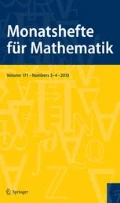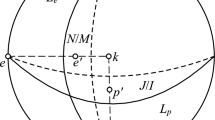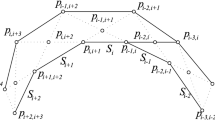Abstract
In this note we introduce the problem of illumination of convex bodies in spherical spaces and solve it for a large subfamily of convex bodies. We derive from it a combinatorial version of the classical illumination problem for convex bodies in Euclidean spaces as well as a solution to that for a large subfamily of convex bodies, which in dimension three leads to special Koebe polyhedra.
Similar content being viewed by others
References
Bezdek, K.: The problem of illumination of the boundary of a convex body by affine subspaces. Mathematika 38, 362–375 (1991)
Bezdek, K.: Hadwiger’s covering conjecture and its relatives. Am. Math. Mon. 99, 954–956 (1992)
Bezdek, K., Khan, M.A.: The geometry of homothetic covering and illumination. In: Discrete Geometry and Symmetry. Springer Proceedings in Mathematics and Statistics, vol 234, pp. 1–30 (2018)
Boltyanski, V.: The problem of illuminating the boundary of a convex body. Izv. Mold. Fil. AN SSSR 76, 77–84 (1960)
Brightwell, G.R., Scheinerman, E.R.: Representations of planar graphs. SIAM J. Discrete Math. 6, 214–229 (1993)
Gohberg, ITs, Markus, A.S.: A certain problem about the covering of convex sets with homothetic ones. Izv. Mold. Fil. AN SSSR 10/76, 87–90 (1960)
Hadwiger, H.: Ungelöste Probleme Nr. 20. Elem. der Math. 12, 121 (1957)
Hadwiger, H.: Ungelöste Probleme Nr. 38. Elem. der Math. 15, 130–131 (1960)
Lángi, Z.: Centering Koebe polyhedra via Möbius transformations, pp. 1–21 (2018). arXiv:1804.07572
Levi, F.W.: Überdeckung eines Eibereiches durch Parallelverschiebungen seines offenen Kerns. Arch. Math. 6(5), 369–370 (1955)
Schneider, R.: Convex Bodies: The Brunn–Minkowski Theory, Encyclopedia of Mathematics and Its Applications, vol. 44. Cambridge University Press, Cambridge (1993)
Soltan, P., Soltan, V.: Illumination through convex bodies. Dokl. Akad. Nauk. SSSR 286, 50–53 (1986)
Acknowledgements
We are indebted to the anonymous referee for careful reading and valuable comments.
Author information
Authors and Affiliations
Corresponding author
Additional information
Communicated by Adrian Constantin.
Publisher's Note
Springer Nature remains neutral with regard to jurisdictional claims in published maps and institutional affiliations.
Károly Bezdek: Partially supported by a Natural Sciences and Engineering Research Council of Canada Discovery Grant. Zsolt Lángi: Partially supported by the National Research, Development and Innovation Office, NKFI, K-119670, the János Bolyai Research Scholarship of the Hungarian Academy of Sciences, and Grants BME FIKP-VÍZ of EMMI and ÚNKP-19-4 New National Excellence Program of the Ministry for Innovation and Technology.
Appendix: Proof of Theorem 4
Appendix: Proof of Theorem 4
The following proof is a spherical analogue of the proof of the Separation Lemma in [1].
Definition 5
Let \(\mathbf {K}\subset \mathbb {S}^d \subset \mathbb {E}^{d+1}\) be a convex body and F be an exposed face of \(\mathbf {K}\). We define the conjugate face of F as a subset of the polar convex body \({\mathbf {K}}^*= \{ \mathbf {x}\in \mathbb {S}^d : \langle \mathbf {x}, \mathbf {y}\rangle \le 0 \hbox { for all } \mathbf {y}\in \mathbf {K}\}\) given by
One should keep in mind that \(\hat{F}\) depends also on \(\mathbf {K}\) and not only on F. So, if we write \(\hat{\hat{F}}\), then it means \((\hat{F})^{\hat{}}\), where the right-hand circumflex refers to the spherical polar body \({\mathbf {K}}^*\). If \(\mathbf {x}\in \mathbb {S}^d\), then let \(\mathbf {H}_{\mathbf {x}}\) denote the open hemisphere of \(\mathbb {S}^d\) with center \(\mathbf {x}\).
The following statement (which one can regard as a natural spherical analogue of Theorem 2.1.4 in [11]) shows that exposed faces behave well under polarity in spherical spaces.
Proposition 1
Let \(\mathbf {K}\subset \mathbb {S}^d \subset \mathbb {E}^{d+1}\) be a convex body and F be an exposed face of \(\mathbf {K}\). Then \(\hat{F}\) is an exposed face of \({\mathbf {K}}^*\) with \(\hat{F}=\bigcap _{\mathbf {y}\in F}\left( {{\,\mathrm{bd}\,}}{\mathbf {H}_{\mathbf {y}}}\cap {\mathbf {K}}^*\right) \), where \(\mathbb {S}^d{\setminus }\mathbf {H}_{\mathbf {y}}\) is a closed supporting hemisphere of \({\mathbf {K}}^*\) for every \(\mathbf {y}\in F\). Moreover, \(\hat{\hat{F}}=F\) and so, \(F\mapsto \hat{F}\) is a bijection between the exposed faces of \(\mathbf {K}\) and \({\mathbf {K}}^*\).
Proof
Without loss of generality we may assume that F is a proper exposed face of \(\mathbf {K}\), i.e., there exists an open hemisphere \(\mathbf {H}_{\mathbf {x}_0}\) of \(\mathbb {S}^d\) such that \(\emptyset \ne F=\mathbf {K}\cap {{\,\mathrm{bd}\,}}\mathbf {H}_{\mathbf {x}_o}\) and \(\mathbf {K}\cap \mathbf {H}_{\mathbf {x}_0}=\emptyset \). It follows that \(\mathbf {x}_0\in \hat{F}\) and so, \(\hat{F}\ne \emptyset \). Now, if \(\mathbf {y}\in F\), then \(\mathbf {K}^*\cap \mathbf {H}_{\mathbf {y}}=\emptyset \) and \(\mathbf {x}\in {{\,\mathrm{bd}\,}}\mathbf {H}_{\mathbf {y}}\) holds for all \(\mathbf {x}\in \hat{F}\). Thus, \(\hat{F}\subseteq \bigcap _{\mathbf {y}\in F}(\mathbf {K}^*\cap {{\,\mathrm{bd}\,}}\mathbf {H}_{\mathbf {y}})\), where \(\mathbf {K}^*\cap \mathbf {H}_{\mathbf {y}}=\emptyset \) holds for all \(\mathbf {y}\in F\). On the other hand, if \(\mathbf {z}\in \bigcap _{\mathbf {y}\in F}(\mathbf {K}^*\cap {{\,\mathrm{bd}\,}}\mathbf {H}_{\mathbf {y}})\) with \(\mathbf {K}^*\cap \mathbf {H}_{\mathbf {y}}=\emptyset \) for all \(\mathbf {y}\in F\), then \(\mathbf {z}\in \mathbf {K}^*\) with \(\langle \mathbf {z},\mathbf {y}\rangle =0\) for all \(\mathbf {y}\in F\) (and therefore \(\mathbf {z}\in \hat{F}\)) implying that \(\bigcap _{\mathbf {y}\in F}(\mathbf {K}^*\cap {{\,\mathrm{bd}\,}}\mathbf {H}_{\mathbf {y}})\subseteq \hat{F}\). Thus, \(\hat{F}=\bigcap _{\mathbf {y}\in F}(\mathbf {K}^*\cap {{\,\mathrm{bd}\,}}\mathbf {H}_{\mathbf {y}})\) with \(\mathbf {K}^*\cap \mathbf {H}_{\mathbf {y}}=\emptyset \) for all \(\mathbf {y}\in F\). As \(\mathbf {K}^*\cap {{\,\mathrm{bd}\,}}\mathbf {H}_{\mathbf {y}}\) is a proper exposed face of \(\mathbf {K}^*\) for all \(\mathbf {y}\in F\) therefore \(\hat{F}\) is a proper exposed face of \(\mathbf {K}^*\). Applying the above argument to the exposed face \(\hat{F}\) of \(\mathbf {K}^*\) one obtains in a straightforward way that \(\hat{\hat{F}}=F\). This completes the proof of Proposition 1.
Proposition 2
Let \(\mathbf {K}\subset \mathbb {S}^d \subset \mathbb {E}^{d+1}\) be a convex body and H be a \((d-1)\)-dimensional greatsphere of \(\mathbb {S}^d\) with \(H\cap \mathbf {K}=\emptyset \). Then \(\mathbf {q}\in {{\,\mathrm{bd}\,}}\mathbf {K}\) is illuminated from \(\mathbf {p}\in H\) with \(\mathbf {p}\ne -\mathbf {q}\) if and only if \(\hat{F}\subset \mathbf {H}_{\mathbf {p}}\), where F denotes the exposed face of \(\mathbf {K}\) having smallest dimension and containing \(\mathbf {q}\in {{\,\mathrm{bd}\,}}\mathbf {K}\).
Proof
Let \(\mathbf {H}_{\mathbf {h}}\) be the open hemisphere with center \(\mathbf {h}\) and boundary H in \(\mathbb {S}^d\) such that \(\mathbf {K}\subset \mathbf {H}_{\mathbf {h}}\). Clearly, \(-\mathbf {h}\in {{\,\mathrm{bd}\,}}{\mathbf {H}_{\mathbf {p}}}\cap {{\,\mathrm{int}\,}}{\mathbf {K}^*} \). Proposition 1 implies that \(F=\bigcap _{\mathbf {x}\in \hat{F}}\left( {{\,\mathrm{bd}\,}}{\mathbf {H}_{\mathbf {x}}}\cap {\mathbf {K}}^*\right) \), where \(\mathbf {H}_{\mathbf {x}}\cap \mathbf {K}=\emptyset \) for all \(\mathbf {x}\in \hat{F}\). Let \([\mathbf {p},\mathbf {q})\) denote the spherical segment of \(\mathbb {S}^d\) with endpoints \(\mathbf {p}\) and \(\mathbf {q}\) containing \(\mathbf {p}\) and not containing \(\mathbf {q}\). Now, \(\mathbf {q}\in {{\,\mathrm{bd}\,}}\mathbf {K}\) is illuminated from \(\mathbf {p}\in H\) if and only if \([\mathbf {p},\mathbf {q})\subset \bigcap _{\mathbf {x}\in \hat{F}}\mathbf {H}_{\mathbf {x}}\), which is equivalent to \(\mathbf {p}\in \bigcap _{\mathbf {x}\in \hat{F}}\mathbf {H}_{\mathbf {x}}\) (because \(\pm \mathbf {q}\in \bigcap _{\mathbf {x}\in \hat{F}}{{\,\mathrm{bd}\,}}\mathbf {H}_{\mathbf {x}}\)). Finally, \(\mathbf {p}\in \bigcap _{\mathbf {x}\in \hat{F}}\mathbf {H}_{\mathbf {x}}\) holds if and only if \(\hat{F}\subset \mathbf {H}_{\mathbf {p}}\). This finishes the proof of Proposition 2.
Now, the following statement follows from Proposition 2 and its proof in a straightforward way.
Corollary 3
Let \(\mathbf {K}\subset \mathbb {S}^d \subset \mathbb {E}^{d+1}\) be a convex body and H be a \((d-1)\)-dimensional greatsphere of \(\mathbb {S}^d\) with \(H\cap \mathbf {K}=\emptyset \). Let \(\mathbf {H}_{\mathbf {h}}\) be the open hemisphere with center \(\mathbf {h}\) and boundary H in \(\mathbb {S}^d\) such that \(\mathbf {K}\subset \mathbf {H}_{\mathbf {h}}\). Then the point set \(\{\mathbf {p}_1,\dots ,\mathbf {p}_n\}\subset H\) illuminates \(\mathbf {K}\) if and only if the open hemispheres \(\mathbf {H}_{\mathbf {p}_1},\dots ,\mathbf {H}_{\mathbf {p}_n}\) with \(-\mathbf {h}\in {{\,\mathrm{bd}\,}}{\mathbf {H}_{\mathbf {p}_i}}\cap {{\,\mathrm{int}\,}}{\mathbf {K}^*} \) for \(1\le i\le n\) have the property that every (proper) exposed face of \(\mathbf {K}^*\) is contained in at least one of the open hemispheres.
Rights and permissions
About this article
Cite this article
Bezdek, K., Lángi, Z. From spherical to Euclidean illumination. Monatsh Math 192, 483–492 (2020). https://doi.org/10.1007/s00605-019-01355-w
Received:
Accepted:
Published:
Issue Date:
DOI: https://doi.org/10.1007/s00605-019-01355-w




